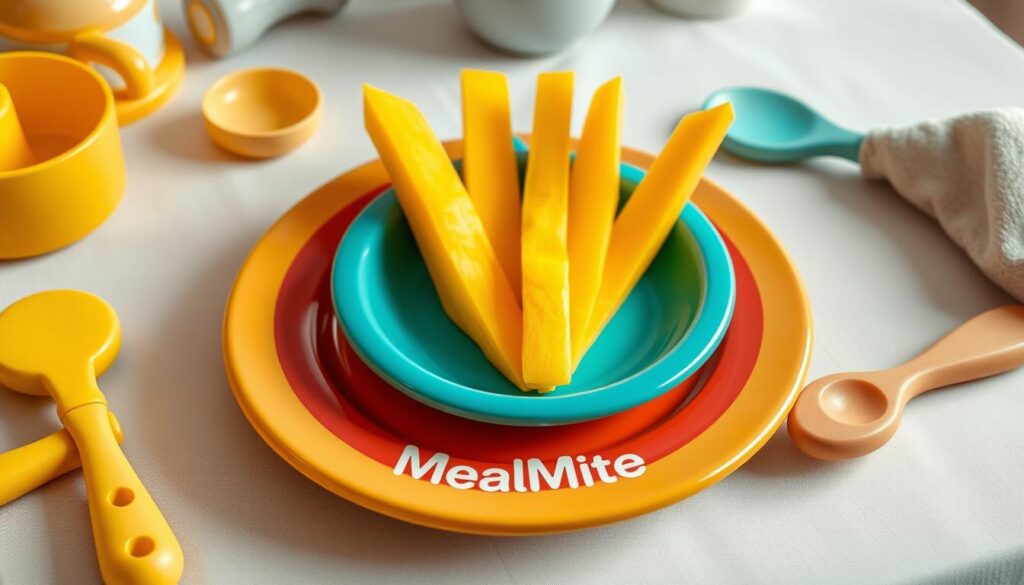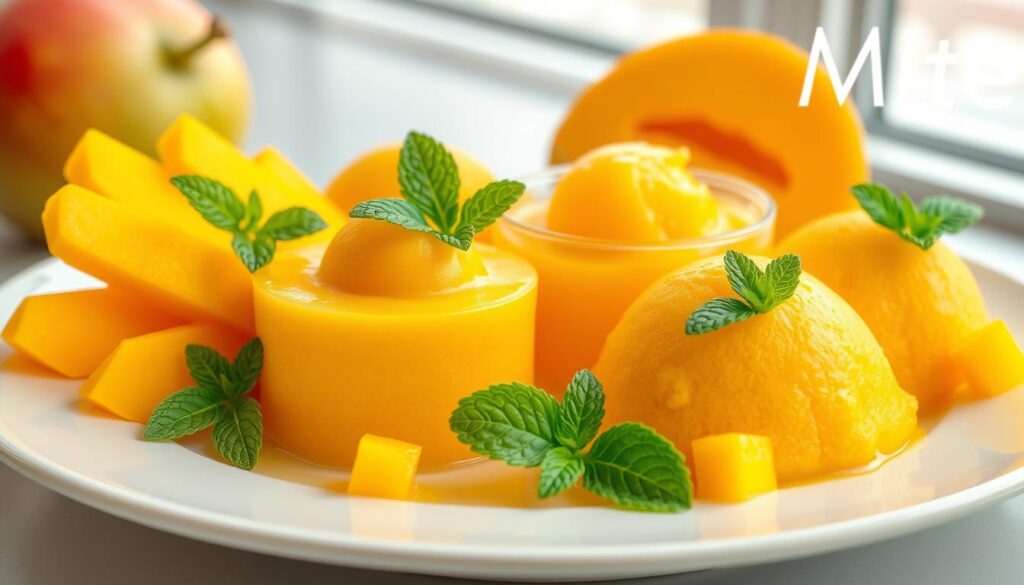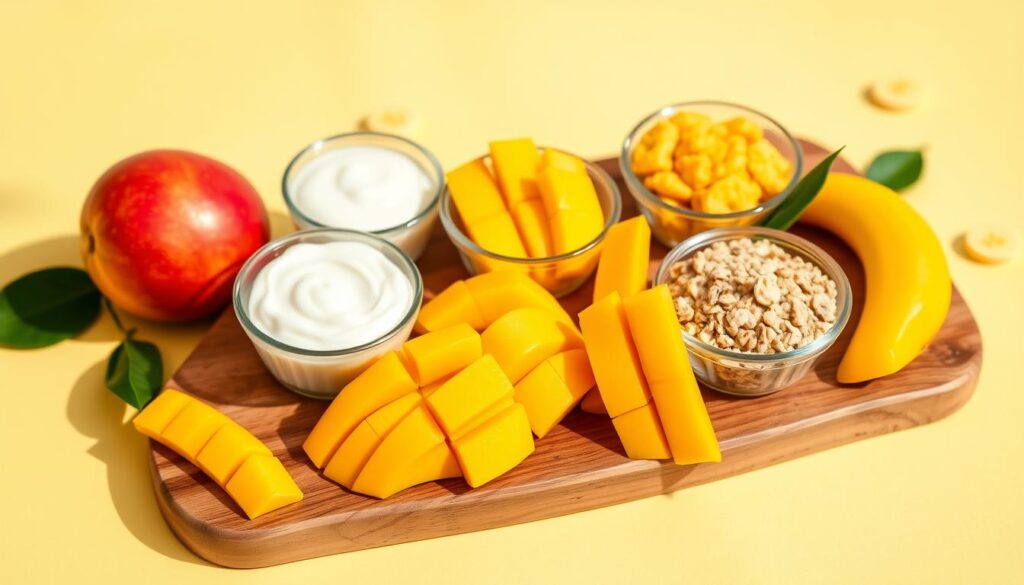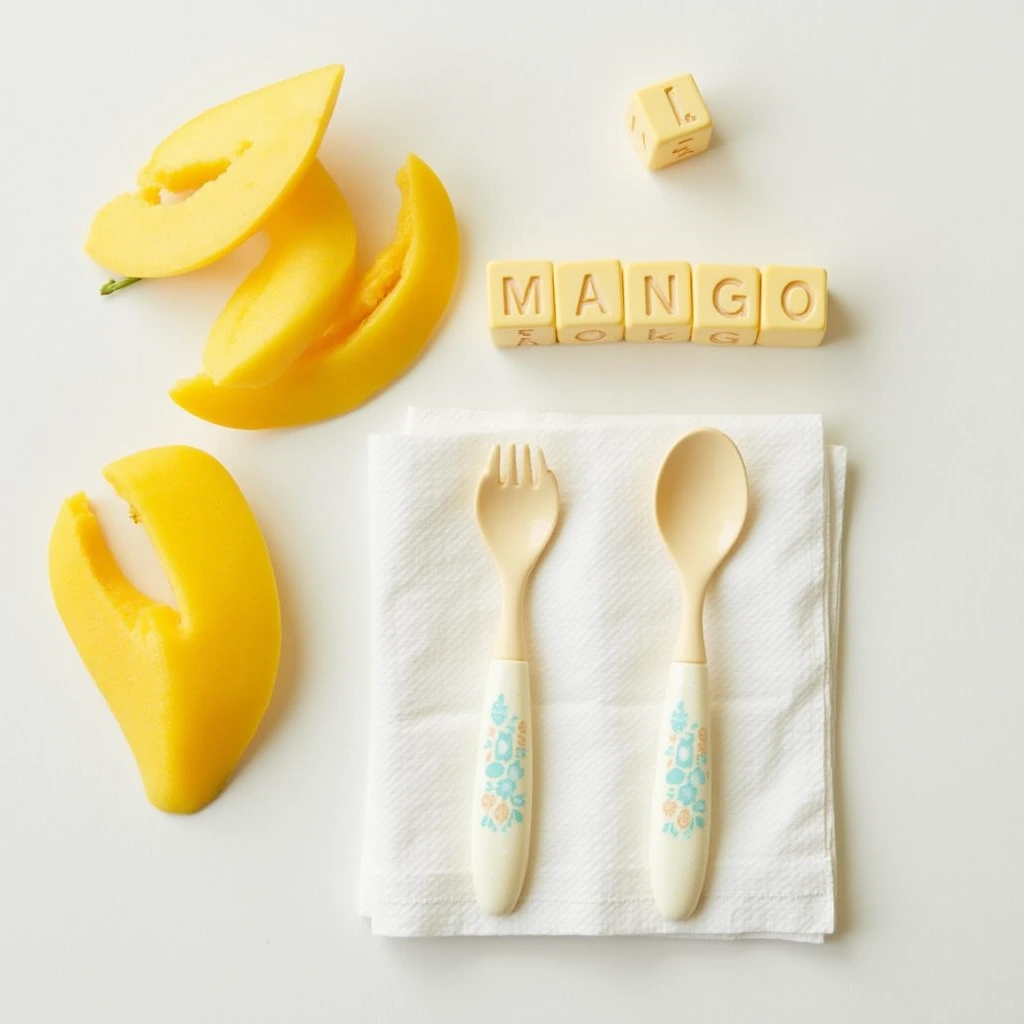Table of Contents
Did you know mangoes come in as many varieties as apples or plums? The Tommy Atkins mango is a favorite among tropical fruit fans in the US. It’s not just for adults; mangoes are also great for babies. They contain fiber, vitamins A and C, folate, copper, and vitamin E.
Introducing mango spears to your baby’s diet can be a big change. These juicy finger foods are great for baby-led weaning, starting around 6 months. As your child grows, you can serve mangoes in different ways. This lets them learn to eat in a way that’s right for them.

Mangoes are usually safe and not often allergenic. But it’s important to prepare them right to avoid choking. The sugars in mangoes are natural and contain lots of good nutrients. By giving your baby ripe, soft mangoes, you’re offering a safe and tasty treat.
Key Takeaways
- Mangoes are suitable for baby-led weaning from 6+ months
- Tommy Atkins is the most common mango variety in the US
- Mangoes are rich in fiber, vitamins A and C, folate, and copper
- Proper preparation is key to preventing choking hazards
- Mango spears can be adapted for different feeding stages
- Ripe, soft mangoes are safest for babies to eat
The Nutritional Benefits of Mangoes for Baby Development
Mangoes are a nutritional powerhouse for your baby’s growth. They are packed with essential vitamins and minerals. These juicy fruits offer numerous health benefits. Let’s explore why mangoes are an excellent addition to your little one’s diet.
Essential Vitamins and Minerals
Mangoes are rich in vital nutrients that support your baby’s development. A 100g serving of ripe Kesar mango provides:
| Nutrient | Amount | Benefit |
|---|---|---|
| Vitamin C | 29.08 mg | Boosts immunity and aids iron absorption |
| Vitamin A | 210 mcg | Promotes healthy eyesight |
| Folate | 90.43 ug | Supports brain development |
| Potassium | 143 mg | Helps maintain fluid balance |
Fiber Content and Digestive Health
With 2.02g of fiber per 100g, mangoes aid in digestion and prevent constipation. The natural enzymes in mangoes also support your baby’s developing digestive system.
Natural Sugar Content and Energy
Mangoes contain 11.3g of carbohydrates per 100g, providing energy for your growing baby. The natural sugars in mangoes offer a healthier alternative to processed sweets.
Remember, mango season typically runs from May to September in the US. Introduce mangoes to your baby around 6-8 months, when they start solids. Always consult your pediatrician before adding new foods to your baby’s diet.
When Can Babies Start Eating Mango Spears
Babies can start eating mango spears at 6 months old. This is when they begin to eat solid foods. Mangoes are sweet and soft, making them great for baby-led weaning. The creamy Ataulfo and fibrous Kent mangoes are good choices for babies.
Start with small amounts of mango and watch for any signs of allergy. Mangoes are not common allergens, but it’s still important to be careful. Choose soft, ripe mangoes for the best taste. Knowing how to grow mangoes is also helpful for making baby food.
For babies 6-9 months old, serve mango as thick spears or puree. As your baby gets older, you can change how you serve the mango:
- 6-8 months: Offer large, graspable spears
- 9-12 months: Provide smaller, bite-sized pieces
- 12+ months: Introduce diced mango for more advanced eaters
Every baby grows at their own pace. Some might enjoy mango spears sooner, while others need more time. Always watch your baby while they eat to keep them safe.
| Age | Mango Preparation | Texture |
|---|---|---|
| 6-8 months | Large spears | Very soft, ripe |
| 9-12 months | Smaller pieces | Soft, slightly firmer |
| 12+ months | Diced | Soft chunks |
Safe Preparation Methods for Baby-Led Weaning
Preparing mango spears for baby-led weaning needs care. You want to make sure your baby can enjoy this fruit safely. Let’s look at the best ways to serve mangoes to your baby.
Choosing the Right Mango Ripeness
Choose mangoes that feel slightly soft, like a ripe avocado. If the stem smells fruity, it’s ripe. Ripe mangoes are soft for your baby to mash with their gums.
Proper Cutting Techniques
Cut mangoes into thick spears or offer the whole mango with most flesh removed. Don’t use cubes, as they can be a choking hazard. For babies 6-9 months, use spears as long as their fingers. This size helps them hold the fruit while exploring new textures.
Size and Shape Guidelines
As your baby grows, change the size of the mango pieces. For 9+ months, use smaller, chopped pieces to help with their pincer grasp. Always watch your baby during meals to keep them safe.
- Roll mango spears in hemp seeds
- Coat pieces with crushed coconut
- Freeze mango chunks for teething relief
Introducing mangoes early can spark a lifelong love for this nutritious fruit. Try different mango recipes to make meals fun and healthy for your baby.
| Age Group | Mango Preparation | Serving Suggestions |
|---|---|---|
| 6-8 months | Large spears, pit with flesh | Offer as finger food |
| 9-12 months | Smaller chunks | Encourage self-feeding |
| 12+ months | Bite-sized pieces | Mix in yogurt or oatmeal |
How to Serve Mango Spears by Age Group
Introducing mango spears to your little one can be a delightful journey. Let’s explore how to serve this juicy fruit as your child grows. We’ll turn it into tasty mango recipes and even mango desserts along the way.
6-8 Months: First Introduction
At this stage, offer large mango spears. The whole pit, with flesh attached, can be great for grasping and sucking. This method aligns with Baby-Led Weaning principles, suitable for babies 6+ months old.
9-12 Months: Advancing Skills
Continue with spears, but also introduce small, soft pieces to practice the pincer grasp. This age is perfect for exploring simple mango recipes. Try mashing mango into yogurt or oatmeal for a nutritious breakfast.
12+ Months: Independent Feeding
Offer diced mango for self-feeding with fingers or utensils. Now’s the time to get creative with mango desserts. A fruit salad can be a fun way to combine mangoes with other fruits.

| Age Group | Mango Preparation | Serving Ideas |
|---|---|---|
| 6-8 Months | Large spears or whole pit | Plain for sucking and grasping |
| 9-12 Months | Spears and small soft pieces | Mixed in yogurt or oatmeal |
| 12+ Months | Diced mango | In fruit salads or smoothies |
Remember, mangoes are rich in vitamins A, and C, and dietary fiber. They’re beneficial for developing babies and toddlers. Always ensure the mango is ripe and soft enough to be easily mashed. With these guidelines, you can confidently introduce this nutritious fruit to your little one’s diet.
Safety Considerations and Choking Prevention
When you give mango spears to your baby, safety is very important. Mangoes are tasty, but you must prepare them right. Cut ripe mangoes into spears or big pieces that are above your baby’s fist. This makes it easy for them to hold and keeps choking risks low.
Don’t use dried or unripe mangoes because they are more likely to cause choking. For younger babies, give them whole mango pits or big spears. As they get older, you can give them smaller pieces. Always watch them while they eat to make sure they’re eating safely.
Introducing finger foods like mangoes helps babies learn to use their mouths. Studies show that with the right safety steps, there’s no more risk of choking. Babies should start with finger foods by 9 months to help them grow.
“Bigger is better when it comes to baby-led weaning. Large pieces of food that babies can grab independently present a lower choking risk for 6-8 month olds.”
Be careful of allergies, especially if your family has a history of latex allergy. Mangoes might cause a reaction in some people with latex allergy. If your baby shows signs of an allergy, like hives or trouble breathing, stop feeding them and call your doctor right away.
- Choose ripe, soft mangoes
- Cut into appropriate sizes based on age
- Supervise all mealtimes
- Watch for signs of allergies
- Consult your pediatrician with concerns
Creative Ways to Enhance Grip and Texture
Introducing mango snacks to your baby can be exciting and fun. Let’s explore some creative ways to make mango spears more engaging and easier for your little one to handle.
Rolling in Healthy Coatings
Make slippery mango spears easier to hold by rolling them in nutritious coatings. Try finely ground baby cereal, hemp hearts, or ground flaxseeds. These add-ons not only improve grip but also boost the nutritional value of your mango recipes.
Temperature Modifications
Experiment with temperature to create interesting sensory experiences. Offer chilled mango spears, which can be soothing for teething babies. This simple trick can make mango snacks more appealing and comforting for your little one.
Texture Combinations
Mix mangoes with other textures to create diverse sensory experiences. Combine mango chunks with yogurt or oatmeal for interesting mango recipes. This approach helps babies develop their palate and improves their ability to handle different food textures.
| Coating | Benefits | Best for Age |
|---|---|---|
| Ground Flaxseed | Omega-3 fatty acids, fiber | 8+ months |
| Hemp Hearts | Protein, healthy fats | 9+ months |
| Baby Cereal | Iron, easy grip | 6+ months |
| Shredded Coconut | Healthy fats, texture | 10+ months |
By incorporating these creative methods, you can make mango snacks more accessible and enjoyable for your baby. Remember to always supervise your child during meals and adjust textures as needed based on their developmental stage.
Storage Tips and Preparation Tricks
Keeping mangoes fresh is important to enjoy them all season. With the right storage and prep, you can use more of your mangoes and waste less.
Refrigeration Guidelines
Put ripe mangoes in the fridge to keep them longer. Store them in the crisper drawer, away from fruits that give off ethylene gas. Cut mangoes should be wrapped in a paper towel and stored in a sealed container. They’ll last 3-5 days.
Freezing Methods
Freezing mangoes is a good way to keep them for up to 6 months. Cut them into spears or cubes and freeze them on a baking sheet. Then, put them in freezer bags for longer storage. Frozen mangoes are great for smoothies or as a cool treat for babies.
Make-Ahead Solutions
Make mango puree ahead of time and freeze it in ice cube trays. Once frozen, transfer the cubes to a freezer bag. This makes it easy to use in baby food or recipes. For older kids, pre-cut mango spears can be stored in the fridge for quick snacks.
| Storage Method | Duration | Best For |
|---|---|---|
| Room Temperature | 2-5 days | Ripening |
| Refrigerator | 5-7 days | Ripe mangoes |
| Freezer | Up to 6 months | Long-term storage |
Proper storage keeps your mangoes fresh for longer. This way, you can enjoy them all year, even when it’s not mango season. Follow these tips to make the most of your mangoes.
Combining Mango Spears with Other Foods
Mango spears open up a world of flavors for your baby’s meals. You can mix them with yogurt or blend into smoothies for yummy mango desserts. They also pair well with iron-rich foods, thanks to their vitamin C.
Try these tasty combinations:
- Mango and yogurt parfait
- Mango-banana smoothie
- Mango and chicken puree
- Mango-oatmeal blend

Spices can make simple mango recipes into exotic treats. A little cinnamon or cardamom can do wonders. Always introduce new foods slowly and watch for any reactions.
| Food Pairing | Nutritional Benefit | Serving Suggestion |
|---|---|---|
| Mango + Yogurt | Protein, Probiotics | Chilled parfait |
| Mango + Spinach | Iron, Fiber | Pureed smoothie |
| Mango + Tofu | Protein, Calcium | Soft cubes |
| Mango + Oatmeal | Fiber, B Vitamins | Warm breakfast |
For a tropical twist, mix mango spears with papaya. This combo is a hit with 65% of mango fans in the US. Use a big mango, about 330 grams, for your recipes.
Signs of Mango Allergies and Sensitivities
Mangoes are a tasty tropical fruit many enjoy. But, some people might have allergic reactions. Knowing the signs is key when you introduce mango to your baby’s diet.
Common Allergic Reactions
Mango allergies are not common but can happen. Look out for these signs after your baby eats mango:
- Skin rashes, especially around the mouth or bottom
- Stomach upset or diarrhea
- Breathing difficulties or wheezing
- Swelling of the lips, tongue, or throat
Some might get contact dermatitis from mango skin. This is because of urushiol, found in mango peel and sap.
When to Consult a Healthcare Provider
If allergies run in your family, especially to latex or other tropical fruits, talk to your doctor first. Get help right away if you see severe signs like trouble breathing or swelling.
Remember, different mango types might affect people differently. Some babies might handle certain mangoes better than others. Always start with small amounts and watch for any odd reactions.
“While mango allergies are uncommon, it’s crucial to be vigilant when introducing this tropical fruit to your baby’s diet. Observing any reactions can help ensure a safe and enjoyable eating experience.”
Conclusion
Mango spears are a great choice for your baby’s diet. They mix nutrition with taste, making them perfect for solid foods. They are a key part of introducing new foods to your baby.
At 6 months, you can start giving mango spears to your baby. They are soft and sweet, great for little ones. Just cut them right to avoid choking risks.
As your baby gets older, try different ways to serve mango spears. This makes eating fun and helps with their motor skills.
Even though mangoes are safe, watch for any signs of allergies. Always talk to your pediatrician before trying new foods. With the right preparation, mango spears can be a big part of your baby’s diet.
FAQ
When can babies start eating mango spears?
Babies can start eating mango spears at 6 months old. Mangoes are good for baby-led weaning and are not common allergens. Choose ripe, soft mangoes and watch your baby while they eat.
What are the nutritional benefits of mangoes for babies?
Mangoes are full of nutrients for babies. They have vitamins A and C for a strong immune system and healthy eyes. They also have fiber, folate, copper, and vitamin E. Natural sugar gives energy to growing babies.
How should I prepare mango spears for baby-led weaning?
Choose ripe, soft mangoes for baby-led weaning. Cut them into thick spears or offer the whole mango with most flesh removed. For 6-9 month olds, spears should be finger-length. Roll spears in hemp seeds or crushed coconut for better grip. Avoid cubes, as they can be a choking hazard.
Are there any safety concerns when feeding mango spears to babies?
Mangoes can be a choking hazard if not prepared right. Always serve ripe, soft mangoes and cut them into safe shapes. Avoid dried mangoes and green mangoes for babies. Never leave your baby alone while eating. Be careful of potential latex allergies, as they may react with mango.
How can I store mango spears for later use?
Store cut mangoes in an air-tight container in the fridge for 3-5 days. Mangoes freeze well for up to 6 months. Prepare mango puree or spears in advance and store them properly. Frozen mango can be thawed for recipes or served in a mesh feeder for teething relief.
Can I combine mango spears with other foods?
Yes! Mango goes well with many foods, adding nutrition and flavor. Mix it with protein like yogurt, chicken, or tofu for a balanced meal. Serve it with iron-rich foods to help iron absorption. Try mango in smoothies, oatmeal, or yogurt. You can also add spices like cinnamon or cardamom to expand your baby’s taste.
What are the signs of a mango allergy in babies?
Mango allergies are rare but watch for signs like skin rashes, especially around the mouth or bottom. Look for gastrointestinal or respiratory problems. Some babies may get contact dermatitis from mango skin. If there’s a family history of allergies, talk to your healthcare provider before introducing mango.
What mango varieties are best for babies?
Tommy Atkins mangoes are common in the United States and good for babies. Choose a ripe, soft mango, regardless of the variety. Make sure the mango is soft enough for your baby’s gums.
How can I make mango spears easier for my baby to grip?
Roll mango spears in baby cereal, hemp seeds, or shredded coconut for better grip. Chilled mango spears can be soothing for teething babies.
When is mango season and how does it affect availability?
Mango season varies by variety and region. In the United States, it’s from May to September. But, thanks to imports, mangoes are available year-round in many stores. Mangoes are more affordable and flavorful during peak season.

